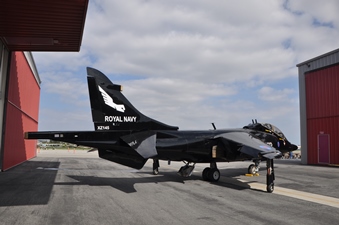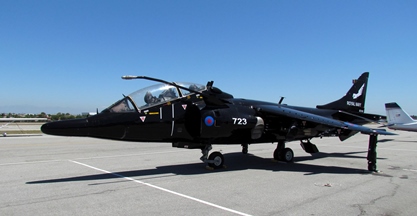The Hawker Siddeley Harrier, developed in the 1960s, was the first of the Harrier Jump Jet series of aircraft. The Harrier is typically used as a ground attack aircraft, though its maneuverability also allows it to effectively engage other aircraft at short ranges. The Harrier is powered by a single Pegasus turbofan engine mounted in the fuselage. The engine is fitted with two air intakes and four vectoring nozzles for directing the thrust generated: two for the bypass flow and two for the jet exhaust. Several small reaction nozzles are also fitted, in the nose, tail and wingtips, for the purpose of balancing during vertical flight. It has two landing gear units on the fuselage and two outrigger landing gear units, one near each wing tip. The Harrier is equipped with four wing and three fuselage pylons for carrying a variety of weapons and external fuel tanks.

The Harrier T.4, photo on the left, is on display at the Western Museum of Flight at Torrance airport in California and is a two-seat training version for the Royal Air Force, equivalent to the GR.3, with a Pegasus Mk 103 engine, laser seeker and radar warning receiver. The Harrier’s VTOL abilities allowed it to be deployed from very small prepared clearings or helipads as well as normal airfields. It was believed that, in a high-intensity conflict, air bases would be vulnerable and likely to be quickly knocked out. The capability to scatter Harrier squadrons to dozens of small “alert pads” on the front lines was highly prized by military strategists and the USMC procured the aircraft because of this ability. Hawker Siddeley noted that STOL operation provided additional benefits over VTOL operation, saving fuel and allowing the aircraft to carry more ordnance.
A HARRIER AT TORRANCE by Frank B. Mormillo
During its February 21, 2015 monthly Celebrity Lecture Series presentation at Zamperini Field on the Torrance Municipal Airport, the Western Museum of Flight rolled out a British Aerospace Harrier T.4 for public viewing to complement the presentation. Although the subject of the presentation was “The Flying Movie is Born,” with the speaker being William Wellman, Junior, son of the man who directed the epic 1928 drama “Wings,” (winner of the very first Academy Award for Best Picture), for the enthusiasts in the audience, the Harrier was the real attention-getter.
On loan from the California Science Center of Los Angeles until at least 2018, British Aerospace Harrier T.4 XZ145 made its first flight on January 20, 1976, and was delivered to the British Royal Air Force on March 8, 1976. By 1982 the Harrier was deployed to RAF Germany, serving with 3 Squadron at RAF Gutersloh, Federal Republic of Germany, from 1984 until it returned to the United Kingdom for service with 233 OCU at RAF Wittering in 1986. By 1995, the Harrier was serving with 20 (R) Squadron, though still at RAF Wittering. On August 16, 1995 XZ145 was assigned to RAF Shawbury for storage, before being transferred to RNAS Culdrose on May 29, 1997 for use by the School of Flightdeck Operations. Subsequently re-assigned to the Royal Navy Fleet Air Arm Fire School at RNAS Predannack, the Harrier was eventually obtained by Everett Aero at Bentwaters.
According to Dennis Jenkins of the California Science Center, although XZ145 had always worn a standard RAF Wrap-around gray and green camouflage color scheme, Everett Aero re-finished the jump jet in 899 Naval Air Squadron colors and markings, with the serial number ZD993, because of its final service with the Royal Navy. However, the Royal Navy did not actually fly or even taxi XZ145, using the airframe instead as a source of spare parts. Looking for artifacts to support specific California Science Center educational objectives (in this case, control during VTOL flight), Jenkins came across the Everett Aero website on which several Harriers were listed for sale. Finding XZ145 to be the most affordable, Jenkins was able to make an acceptable deal for direct purchase and import. While keeping the 899 NAS colors and markings, Jenkins did return the correct serial number to the Harrier. He is still awaiting a few missing bits and pieces that are expected to arrive in time to make the airplane totally complete by the time that it is finally moved to the California Science Center in 2018.
In the meantime, XZ145 will be one of the stars of the Western Museum of Flight’s collection at Torrance. Over the years, Western Museum of Flight Director Cynthia Macha has collaborated with Ken D. Phillips, Curator of Aerospace Science at the California Science Center, on a number of other displays and projects, including a Northrop F-20 Tigershark and a T-38 Talon.

